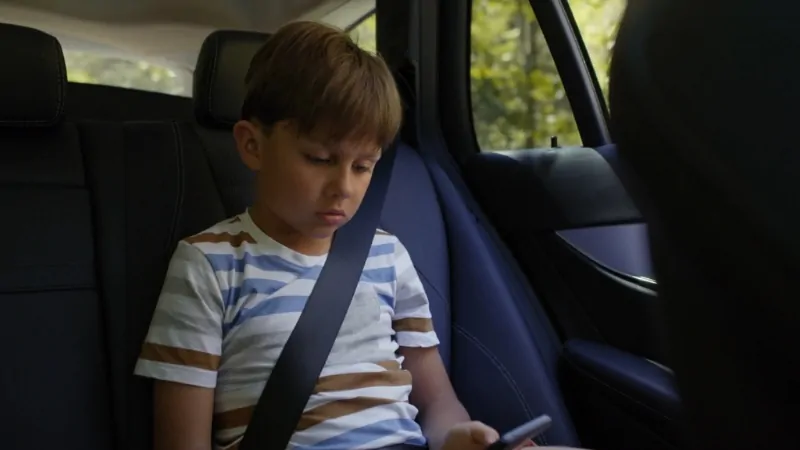Car seat laws serve as one of the most important tools in preventing child injuries and fatalities during vehicle travel.
Regulations are designed to protect children based on their age, weight, and height, yet each state sets its own standards.
Federal laws establish a foundation, but states can strengthen or weaken these measures.
Parents are encouraged to follow best practices rather than rely solely on legal requirements to keep their children secure on every trip.
With all that in mind, we believe it is necessary to talk about car seat laws in each state in greater detail.
Table of Contents
ToggleDifferences Between States
| State | Rear-Facing Required Until | Forward-Facing Required Until | Booster Seat Required Until | Seat Belt Allowed From | Back Seat Required Until | Taxi Exempt? | Fine |
| California | Age 2 | Age 4 | Age 8 or 4’9” | 8–12 years | Age 13 | No | $100+ |
| Texas | Age 2 | Age 4 | Age 8 or 4’9” | 8–12 years | Age 8 | Yes | $25–$250 |
| Florida | Age 2 | Age 4 | Age 6 | 6–12 years | None | Yes | $60 |
| New Jersey | Age 2 | Age 4 | Age 8 or 4’9” | 8–12 years | Age 13 | No | $75–$100 |
| Minnesota | Age 2 | Age 4 | Age 8 or 4’9” | 8–12 years | Age 13 | No | $50–$100 |
| South Dakota | Age 2 | Age 4 | Age 5 | 5–12 years | None | Yes | $25 |
Car seat laws in the United States range from highly protective to minimally enforced, reflecting a patchwork of regulatory approaches that evolve alongside new safety research, federal recommendations, and local legislative priorities.
States such as California, Connecticut, and New Jersey have established some of the strictest standards in the country.
These states require children to remain rear-facing until at least age two, use booster seats until a minimum age or height (often age eight or 4’9″), and remain in the back seat until age 13.
Their laws tend to align closely with NHTSA and IIHS best practices, which emphasize safety over convenience.
Conversely, states like South Dakota and Florida have comparatively relaxed regulations.
For instance, Florida law only requires booster seats up to age six, and allows children to ride in the front seat at any age, with no formal back seat requirement.
South Dakota permits the use of adult seat belts starting at age five, one of the lowest thresholds nationwide.
National Implications of Lenient Laws:
- In 2023, 192 children killed in vehicle crashes were unrestrained, and many more were using inappropriate restraint types for their size and age.
- Among children 37–53 inches tall, 23% were using only seat belts, despite not meeting the height benchmark for safe belt use.
- According to IIHS research, children in booster seats are 45% less likely to be injured than those using seat belts alone.
- Injuries caused by car accidents can result in long-term complications similar to those caused by birth injuries, which may require extensive medical and legal support.
Reform and Alignment with Federal Guidelines
Several states, including Michigan, Minnesota, Oregon, and Washington, have recently updated their car seat laws to reflect evidence-based recommendations.
These newer laws shift away from age-only thresholds and instead consider height and weight, which are more accurate indicators of when a child can safely transition between restraint types.
For example:
- Minnesota requires booster seats until age 8 or 4’9″, aligning with NHTSA guidance.
- Washington State’s updated law mandates rear-facing seating until age 2 and back seat use until age 13, effectively mirroring national best practices.
These progressive states also invest more in public education, car seat checks, and community enforcement, recognizing that legislation alone isn’t enough, awareness and accessibility are equally critical.
Why the Variation?

The variation in state laws reflects:
- Differing interpretations of safety research
- The influence of advocacy groups and pediatric associations
- Budgetary and logistical concerns (especially in rural or lower-income states)
- Political will, with some legislatures resistant to increasing mandates on parents or expanding enforcement costs
This inconsistency leaves many parents unsure of what’s both legal and safe, and places a burden on caregivers to distinguish between minimum compliance and optimal protection.
Overview of State-Specific Laws
Each state establishes its own child passenger safety regulations, which can differ significantly in age cutoffs, height/weight rules, and enforcement.
Generally:
- Most states require rear-facing until at least age 2.
- Booster seat laws typically require use until age 8 or a height of 4’9”, whichever comes first.
- Some states, like New York and California, mandate that children remain in the back seat until age 13, based on airbag injury risks.
- Exemptions for taxis, school buses, or rideshares vary widely by state.
- Fines for violations range from as low as $25 (South Dakota) to over $100 in states like California and New Jersey.
Sample Enforcement Differences:
- California: Back seat required until age 13, no taxi exemption, fine $100+
- Texas: Back seat only until age 8, taxis exempt, fines from $25–$250
- Minnesota: Strong alignment with federal best practices; booster required to 4’9″, no taxi exemptions
Parents should always review their state’s specific laws and consider exceeding them to align with current research-backed best practices.
Federal Guidelines and Best Practices
Federal Motor Vehicle Safety Standard 213 (FMVSS 213) establishes minimum performance standards for all child restraint systems sold in the U.S.
These standards govern crash performance, design, and labeling, but they don’t dictate how long children should use each type of seat.
That’s where NHTSA and IIHS offer evidence-based best practices, which parents and caregivers are encouraged to follow:
| Seat Type | Recommended Use |
| Rear-Facing | Until at least age 2, and as long as possible, up to the seat’s height or weight limit (often 35–40 lbs). |
| Forward-Facing (Harness) | Until the child outgrows the seat’s limits, often up to age 6–7. Always use a top tether. |
| Booster Seat | Until a seat belt fits properly, usually until 4’9” in height, which often occurs between ages 8–12. |
| Seat Belt Alone | Only when a child passes the 5-Step Fit Test. |
| Back Seat | Always recommended until at least age 13 to avoid injury from airbags. |
These guidelines reflect decades of crash research showing that premature transitions dramatically increase risk, even if allowed by law.
Key Definitions in Car Seat Laws
Legal texts and child passenger safety regulations can be confusing without a solid understanding of their terminology.
Terms like child restraint system, appropriate system, and proper use are foundational to both legal compliance and actual safety, but their meanings aren’t always clear without context.
Below is a breakdown of the most important terms found in car seat laws, explained in detail:
Child Restraint System (CRS)

A child restraint system refers to any federally-approved device designed to secure a child and reduce the risk of injury or death in a motor vehicle crash. These include:
- Rear-facing car seats
- Forward-facing car seats with a harness
- Belt-positioning booster seats
Each type is engineered to match a child’s developmental stage, body size, and physical needs.
FMVSS 213 mandates performance and design standards for all CRSs sold in the U.S.
The system must be used according to the manufacturer’s specifications, which often exceed the basic requirements of state law.
Rear-Facing Seat
This type of seat is used for infants and toddlers, typically from birth up to 35–40 lbs or more, depending on the model.
It is considered the safest orientation, especially for young children with underdeveloped spinal structures.
- In a crash, the rear-facing position spreads crash forces across the entire back, neck, and head, reducing the chance of spinal injury.
- Best Practice: Keep children rear-facing as long as possible, until they reach the seat’s height or weight limit, not just until age 2.
Forward-Facing Seat (Harnessed)
According to the National Digital Car Seat Check Form data, only 12% of car seats checked are forward-facing car seats with a harness, yet they have the highest misuse rate of 80%! Be sure your car seat is used correctly. Schedule a virtual appointment: https://t.co/sJPEtzdDOY pic.twitter.com/W9IKOC1oGj
— NCPSB (@NCPSB) April 29, 2024
Used for toddlers and young children who have outgrown the rear-facing seat, forward-facing car seats use a 5-point harness to secure the child at the shoulders and hips.
This type of seat provides robust upper body protection, especially in frontal crashes.
Some forward-facing seats allow use up to 65–90 lbs, depending on the model.
Once again, transitions should be based on the child’s height and weight, not simply age.
Top tether use is recommended, and often required, for added protection against head movement in a crash.
Misuse or omission of tethers is one of the most common safety errors with these seats.
Booster Seat
Booster seats are designed for children who have outgrown forward-facing harness seats but are not yet tall enough for adult seat belts to fit properly.
A booster lifts the child’s body so that the lap belt sits low across the thighs and the shoulder belt crosses the center of the chest and shoulder, rather than the neck or face.
There are two main types:
- High-back boosters – Offer head and neck support and better belt positioning.
- Backless boosters – Convenient but provide less protection; appropriate only when headrests are present.
Children typically need boosters until they are at least 4’9” tall and 80–100 lbs, which occurs between ages 8–12.
Appropriate System

This term often appears in both legislation and manufacturer manuals. It means a restraint that:
- Matches the child’s current weight and height
- Fits correctly in the specific vehicle
- Complies with both the law and the seat’s user instructions
Using an “appropriate” system is not only a legal requirement in many states, but also a safety imperative.
Installing or using a seat outside of its designated limits, even unintentionally, can void its protection in a crash.
Proper Use
“Proper use” goes beyond just putting a child into a seat. It refers to full compliance with:
- The manufacturer’s instructions
- Correct installation in the vehicle
- The child is being appropriately restrained (harness adjusted properly, tether connected, etc.)
The NHTSA estimates that 46% of child restraints are misused in ways that could reduce their effectiveness.
The term “proper use” in law aims to address this by requiring correct and safe usage, not just the presence of a seat.
Statutory Terms That May Cause Confusion

Legal language can vary dramatically by state, and wording matters.
Phrases like:
- “And/or”
- “Appropriate restraint”
- “Properly secured”
- “In accordance with manufacturer instructions”
…can significantly impact interpretation and enforcement.
For example, “and/or” may imply that either height or weight must be met, while some states require both.
These nuances affect how and when parents are legally allowed to transition children between seat types.
Exemptions
Some laws include exemptions for certain vehicles or scenarios, such as:
- Taxis and rideshares
- School buses
- Commercial transport
- Antique or classic cars
However, safety experts strongly advise using child restraints in all vehicles, regardless of exemptions.
Even if a state does not legally require a car seat in a taxi, children remain at equal risk in the event of a crash.
Summary
@countrykidscarseatsafety The USA is in the middle of a 2-year period of updates to our federal car seat regulations! Here is what the average parent or caregiver needs to know without boring you with too much technical jargon and bureaucratic mumbo jumbo. If your car seat was made before these updated standards, please know that it is perfectly safe to continue using and will do an excellent job of protecting your child in a crash when used correctly! Always read and follow your car seat and vehicle manufacturer’s instructions! The best car seat is still one that fits your child, fits your vehicle, and you can use correctly on every ride! #cpst #cpstsoftiktok #childpassengersafetytech #childpassengersafetytechnician #childpassengersafetytok #carseateducation #carseatsafety #carseatsafetytok #carseattiktoks #carseattok #infantcarseat #babycarseat #rearfacingcarseat #convertiblecarseat #allinonecarseat #rotatingcarseat #forwardfacingcarseat #boosterseat #boosterseatsafety #babies #toddlers #preschoolers #kids #mom #dad #parents #momtok #dadtok #momsoftiktok #dadsoftiktok #momlife #dadlife #buckleup ♬ original sound – Emily Roberts
Car seat laws serve as a foundation, but they often represent only the minimum level of safety.
A poorly maintained A/C unit in your car can cause harm to your health due to mold growth and stale air.
Parents and guardians hold the responsibility to go further than the law requires by applying best practices recommended by experts.
Investing time in learning about car seat installation, checking recalls, and following updated guidelines can make the difference between safety and tragedy.








